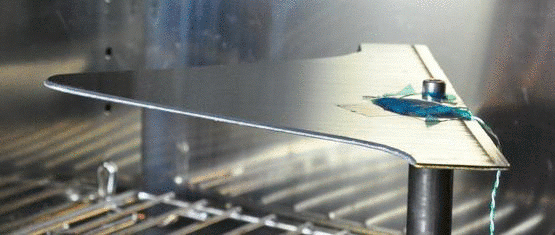We asked Eric Eckstein, the recipient of the prestigious Jefferson Goblet award for ‘overall best student paper’ at the 57th AIAA/ASCE/AHS/ASC Structures, Structural Dynamics and Materials Conference, about his work with ‘morphing’ composites. The following is a guest post about his journey to Bristol and with his composites research as an Advanced Composites postgraduate researcher with the ACCIS CDT.

Bristol has been my home for the past four years, having originally been born and raised in the USA. Our university is one of the most well-known in the field of composites research, and was really a perfect fit for my interests in morphing structures. The big idea behind morphing is to open up new ways of changing the shape of an object. Traditionally, engineers get things to move about using a collection of hinges and actuators, but in many situations, it’s better to facilitate movement using organic flexing and twisting motions. Nature has been using these morphing techniques for millennia, we see it in action every time a flower pivots itself to track the sun, or a pine cone closes up in the rain. Meanwhile, engineers aim to exploit the same principles in order to make everything from more efficient aircraft to haptic feedback touch screens. This is all great, but what really turned me onto the subject was an opportunity to achieve morphing in a simple, elegant manner.
Most moving structures have actuators separate from the structure, just like how our muscles are separate from our bones. Morphing structures, like those sun-tracking flowers, have their muscle and structure built into one. For cases where engineers can take the same approach, their moving structures won’t need hinges, pistons, or any other steampunk-like hardware, thus they can be made beautifully simple.


One of the biggest challenges we face is finding a good structural muscle. The perfect material for the job would be able to expand and contract on command, much like our own muscles, yet be stiff and strong enough to bear great loads. A great deal of progress has been made on this front using metals and polymers which respond to heat by expanding or contracting, but composite materials open up a whole new world of possibilities. Because their expansion and stiffness properties can be accurately tailored by the designer, they can allow for a rich variety of movements, everything from bending, twisting, to snapping shut like a venus fly-trap. I think that working with composite materials is akin to an artist swapping out his charcoal pencil for a whole pallet of rich colours.
The simplicity of a thermally-driven morphing structure can give them a natural durability in adverse environments, such as salty seas or hot jet exhausts. The right materials need to be found, of course, and that’s one of our main focuses. Metal-matrix and ceramic matrix composites have given us promising results, however these materials are still very much adolescent developments, compared to mankind’s established metallics knowledge.
We hope of course that our technology is picked up by the aerospace industry, but the real icing on the cake would be to find other, much broader applications. I’ve read about an idea where morphing micro-capsules of a virus-fighting drug could be injected into your body, lying in wait for months until you get a fever. That increase in body temperature triggers the thermally-driven morphing capsule to release the drug automatically. Who knows what other applications exist?

